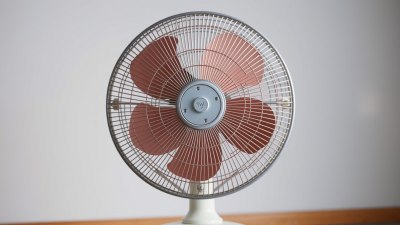Why You Can't Think Clearly When a Fan Is Blowing at the Wrong Angle
Explore how the angle of airflow from a fan can disrupt cognitive function and affect your ability to think clearly.

Image created with Flux Schnell
Many people rely on fans to keep cool and stay comfortable, especially during hot or stuffy days. However, have you ever noticed that when a fan blows air at the wrong angle, it seems harder to focus or think clearly? This phenomenon is not just a matter of discomfort—it has a physiological and psychological basis that affects cognition. Understanding why the direction of airflow from a fan can impair mental clarity reveals fascinating interactions between sensory input, comfort, and brain function.
The Sensory Impact of Airflow on Cognitive Function
Airflow from a fan doesn't just cool the skin; it interacts with our sensory receptors in the body. When air hits certain parts of the skin at uncomfortable angles or intensities, it can trigger sensory irritation or distraction. The skin contains mechanoreceptors and thermoreceptors, specialized nerve endings that detect touch, pressure, temperature, and wind. If a fan’s airflow creates an uneven or excessive sensation, these receptors send signals to the brain signaling potential discomfort or stress.
This sensory input can lead to increased distractibility, as the brain has to process these extraneous signals alongside cognitive tasks. The constant adjustment to an uncomfortable breeze often diverts mental resources away from problem solving, attention, and memory, resulting in less clear thinking.
Thermoregulation and Its Effect on Mental Performance
The body aims to maintain a stable internal temperature for optimal brain function. When skin temperature shifts too rapidly or unevenly due to an improperly angled fan, thermoregulatory mechanisms kick in. For example, if cold air blows directly on sensitive skin areas such as the face or neck at a sharp angle or force, the body might perceive this as chilly, prompting subtle shivering or muscle tension to conserve heat. These physiological responses can consume energy and distract cognitive processes.
Focus Disruption Due to Physical Discomfort
Discomfort is one of the most immediate cognitive distractors. When a fan blows air at an awkward angle—such as directly into the eyes, ears, or back of the neck—it can dry the eyes, create noise irritation, or produce a chilling sensation. All these effects contribute to physical discomfort that intrudes on brain activity. It is difficult to sustain attention when there is a persistent nuisance like dry eyes or a cold neck.The Role of Noise and Air Movement Patterns
Fans produce a characteristic white noise from the blades spinning and air movement over surfaces. At certain angles, the noise frequency and airflow can change dramatically, increasing disruption. If the fan is angled so that the air causes papers or objects to flutter, the added visual distraction exacerbates difficulty concentrating.Cognitive Load and Environmental Stressors
Cognitive load theory explains that the brain has a limited capacity for information processing. Environmental stressors increase extraneous cognitive load, making complex thinking harder. Uncomfortable airflow from a fan at the wrong angle is precisely such an environmental stressor. It adds competing stimuli that consume working memory and executive function resources.Neurological Responses to Discomfort and Their Effects on Clarity
Neural pathways linking sensory areas with prefrontal cortex—responsible for higher-order thinking—are activated during discomfort. The anterior cingulate cortex and insular cortex, which process pain and discomfort sensations, can modulate attention focus by redirecting neural activity toward dealing with perceived threats or irritants. Even if the discomfort from airflow is mild, this interrupts neural networks tuned for cognitive tasks.Psychological Effects of Uncomfortable Airflow
Beyond physiological distractions, uncomfortable airflow can influence mood and stress levels. Air forced onto the face or sensitive skin areas might cause feelings of agitation or restlessness. Over time, negative associations with this sensory input create anticipatory anxiety about concentration sessions near the fan.Strategies to Optimize Fan Use for Clear Thinking
To ensure maximum cognitive performance with a fan, it’s crucial to adjust the angle and intensity of airflow appropriately. Instead of directing air straight at the face or neck, aim fans toward less sensitive regions or use a broader oscillation that creates gentle circulation without cold drafts.The Science of Thermal Comfort in Cognitive Environments
Research in environmental psychology and occupational health emphasizes the importance of thermal comfort for optimal performance. Thermal comfort is achieved when the body does not need to activate cooling or heating responses excessively, allowing the brain to operate efficiently. Fans that produce uneven or misdirected airflow compromise this balance.Integrating Airflow Control into Workspace Design
Modern workspace designs increasingly incorporate environmental controls that address airflow, lighting, and sound. Adjustable fans with programmable angles and speeds allow users to customize their immediate microclimate. This personalization supports sustained concentration by minimizing sensory intrusions.











